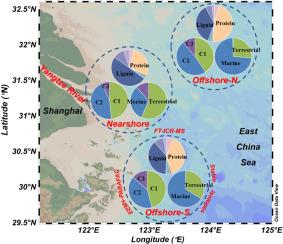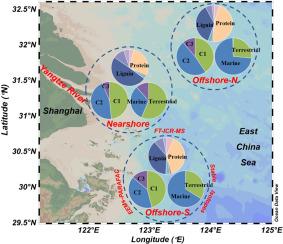Characterization of sediment organic matter in the outer Yangtze River Estuary using stable isotopes, optical techniques, and FT-ICR-MS: Implications for the carbon burial mechanism
IF 12.4
1区 环境科学与生态学
Q1 ENGINEERING, ENVIRONMENTAL
引用次数: 0
Abstract
The burial of sediment organic matter (SOM) in the estuary and shelf plays an important role in the global carbon cycle. However, it is challenging to determine the source, composition, and burial of SOM in the coastal sea, especially at the molecular level. This was explored in the coastal area outside the largest Yangtze River of China with multiple techniques including elemental and stable isotopic analysis, absorption spectroscopy, fluorescence excitation-emission matrices coupled with parallel factor analysis (EEMs-PARAFAC), and ultra-high resolution Fourier transform ion cyclotron resonance mass spectrometry (FT-ICR-MS). The end-member mixing analysis based on δ13C and δ15N showed a dominance of marine contribution (up to 70%) at most stations while the terrestrial contribution increased to >55% nearshore in summer at a high fluvial sediment flux. This was consistent with the offshore decreasing humic-like C1 and C2, humification index (HIX), %lignin-like compounds, and %CHO but increasing tryptophan-like C3, biological index (BIX), %protein-like compounds, and %CHOS from EEMs-PARAFAC and FT-ICR-MS analysis. The %clay correlated positively with SOM content, HIX, %lignin-like compounds, O/C, and modified aromaticity index (AImod) but correlated negatively with %C3, H/C, and the relative abundance of labile formulas (MLBL), while %silt showed contrasting correlations. These results indicated the fine clay sediments adsorbed more humified, aromatic, oxygenated, and terrestrial compounds that were probably more resistant to biodegradation and thus had a higher burial efficiency than those on the silty sediments. Principal component analysis based on SOM indices further revealed different characteristics of SOM in the nearshore, northern offshore, and southern offshore regions, which were probably dependent on the delivery by local current systems. Overall, these findings contributed to unraveling the source and molecular composition of SOM associated with different grain size sediments and local current delivery, which are fundamental for understanding the factors underlying carbon burial in the complex coastal environment.


利用稳定同位素、光学技术和 FT-ICR-MS 分析长江口外沉积物有机质的特征:对碳埋藏机制的启示
沉积有机物(SOM)在河口和陆架的埋藏在全球碳循环中起着重要作用。然而,确定近岸海域 SOM 的来源、组成和埋藏,尤其是分子水平的确定,是一项挑战。为此,我们在中国最大的长江流域以外的沿岸地区进行了探索,采用了多种技术,包括 元素和稳定同位素分析、吸收光谱、荧光激发-发射矩阵耦合平行因子分析(EEMs-PARAFAC) 和超高分辨率傅立叶变换离子回旋共振质谱(FT-ICR-MS)。根据 δ13C 和 δ15N 进行的末端分子混合分析表明,在大多数站点,海洋成分占主导地位(高达 70%),而在夏季河道沉积物流量较大的近岸,陆地成分占比增加到 55%。这与 EEMs-PARAFAC 和 FT-ICR-MS 分析得出的近岸腐殖样 C1 和 C2、腐殖化指数 (HIX)、木质素类化合物百分比和 CHO 百分比减少,而色氨酸样 C3、生物指数 (BIX)、蛋白质类化合物百分比和 CHOS 百分比增加的结果一致。粘土百分比与 SOM 含量、HIX、类木质素化合物百分比、O/C 和改良芳香指数(AImod)呈正相关,但与 C3 百分比、H/C 和易变配方相对丰度(MLBL)呈负相关,而淤泥百分比则显示出截然不同的相关性。这些结果表明,与淤泥沉积物相比,细粘土沉积物吸附了更多的腐殖化、芳香化、含氧和陆生化合物,这些化合物可能更耐生物降解,因此具有更高的埋藏效率。基于 SOM 指数的主成分分析进一步揭示了近岸、北部近海和南部近海区域 SOM 的不同特征,这可能与当地海流系统的输送有关。总之,这些研究结果有助于揭示与不同粒径沉积物和当地海流输送有关的 SOM 的来源和分子组成,这对了解复杂沿岸环境中碳埋藏的基本因素至关重要。
本文章由计算机程序翻译,如有差异,请以英文原文为准。
求助全文
约1分钟内获得全文
求助全文
来源期刊

Water Research
环境科学-工程:环境
CiteScore
20.80
自引率
9.40%
发文量
1307
审稿时长
38 days
期刊介绍:
Water Research, along with its open access companion journal Water Research X, serves as a platform for publishing original research papers covering various aspects of the science and technology related to the anthropogenic water cycle, water quality, and its management worldwide. The audience targeted by the journal comprises biologists, chemical engineers, chemists, civil engineers, environmental engineers, limnologists, and microbiologists. The scope of the journal include:
•Treatment processes for water and wastewaters (municipal, agricultural, industrial, and on-site treatment), including resource recovery and residuals management;
•Urban hydrology including sewer systems, stormwater management, and green infrastructure;
•Drinking water treatment and distribution;
•Potable and non-potable water reuse;
•Sanitation, public health, and risk assessment;
•Anaerobic digestion, solid and hazardous waste management, including source characterization and the effects and control of leachates and gaseous emissions;
•Contaminants (chemical, microbial, anthropogenic particles such as nanoparticles or microplastics) and related water quality sensing, monitoring, fate, and assessment;
•Anthropogenic impacts on inland, tidal, coastal and urban waters, focusing on surface and ground waters, and point and non-point sources of pollution;
•Environmental restoration, linked to surface water, groundwater and groundwater remediation;
•Analysis of the interfaces between sediments and water, and between water and atmosphere, focusing specifically on anthropogenic impacts;
•Mathematical modelling, systems analysis, machine learning, and beneficial use of big data related to the anthropogenic water cycle;
•Socio-economic, policy, and regulations studies.
 求助内容:
求助内容: 应助结果提醒方式:
应助结果提醒方式:


